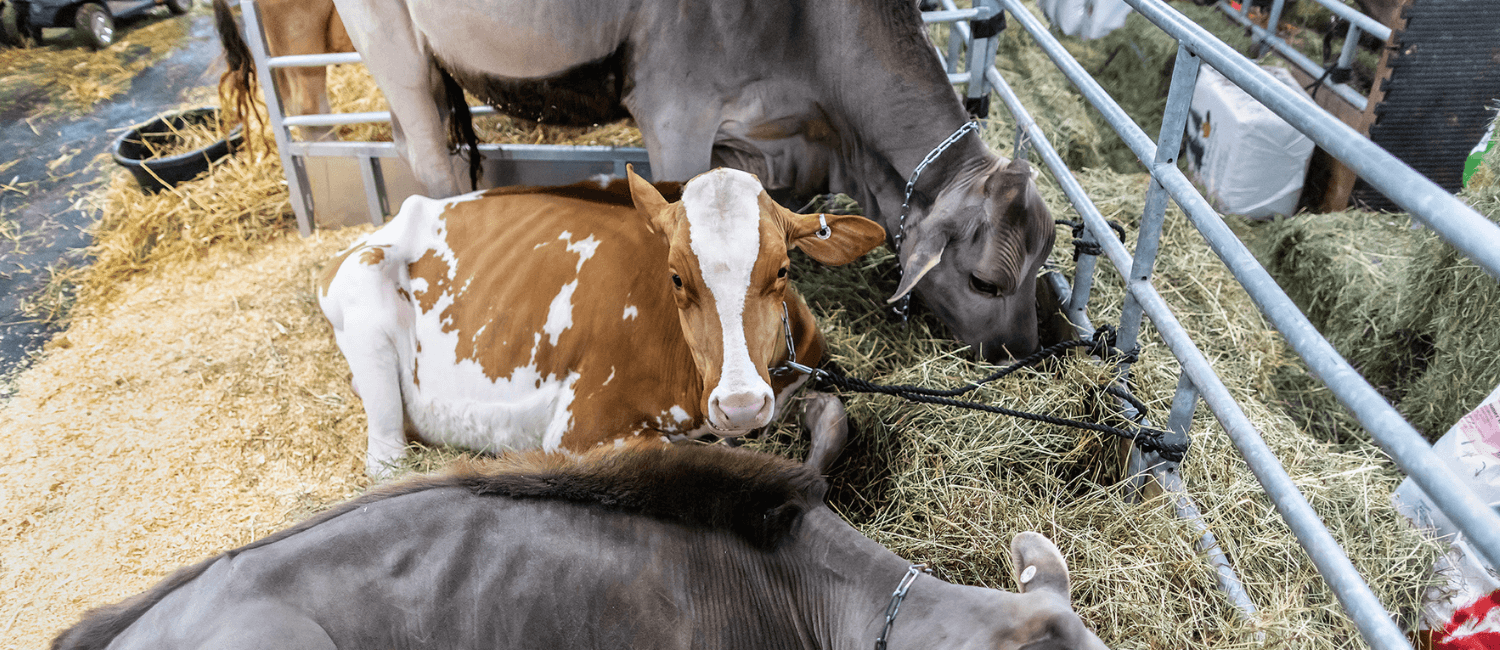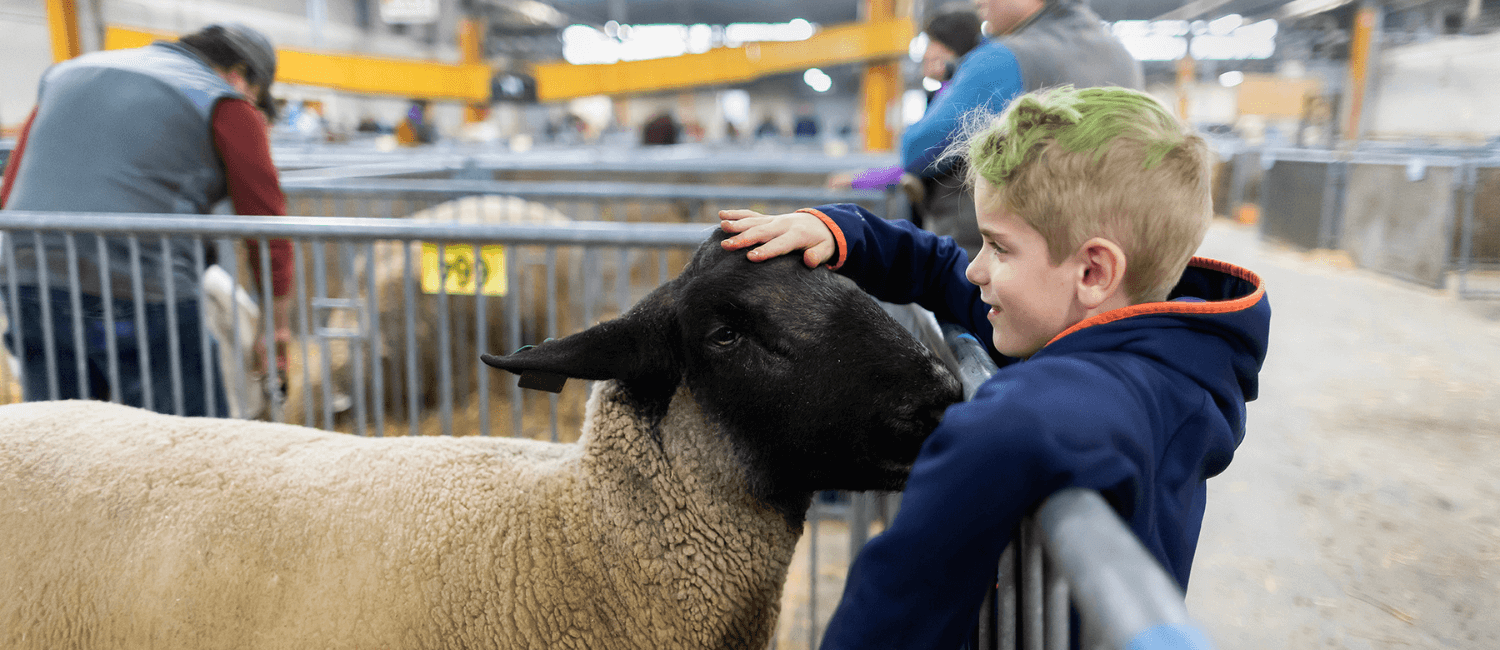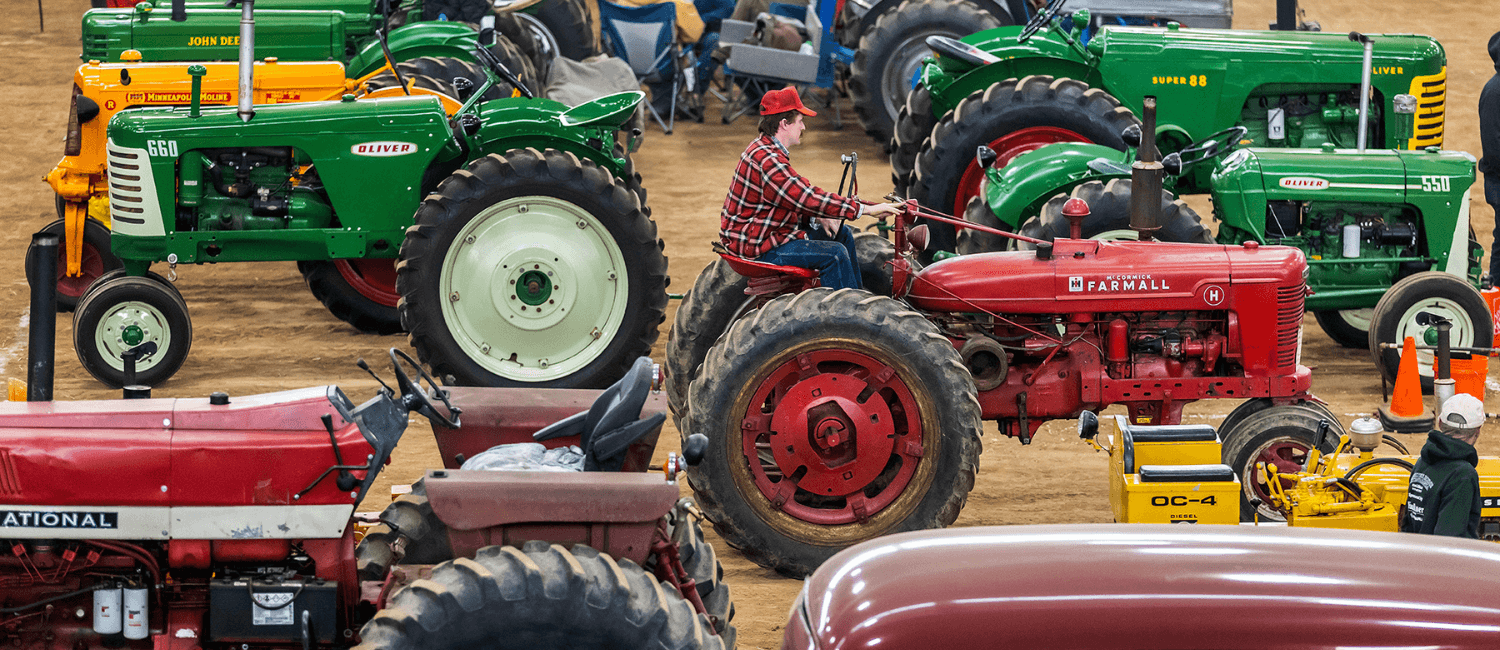 Farmers young and old from around the Commonwealth of Pennsylvania show off their prize animals at the state’s Farm Show, held in a million-square-foot complex in Harrisburg each winter. The School of Veterinary Medicine’s faculty and staff engaged with visitors and leaders throughout the event, underscoring the essential expertise and services that the school and its graduates contribute to the state. (Photo Credit: Eric Sucar)
Farmers young and old from around the Commonwealth of Pennsylvania show off their prize animals at the state’s Farm Show, held in a million-square-foot complex in Harrisburg each winter. The School of Veterinary Medicine’s faculty and staff engaged with visitors and leaders throughout the event, underscoring the essential expertise and services that the school and its graduates contribute to the state. (Photo Credit: Eric Sucar)
At the 107th Pennsylvania Farm Show last week, with the theme ‘Rooted in Progress,’ the School of Veterinary Medicine’s importance to the state’s agricultural industry was on full display.
The last year has been a tough one for poultry farmers. Outbreaks of highly pathogenic avian influenza (HPAI) have struck commercial flocks in 47 states, necessitating widespread population culling and driving egg prices sky-high.
“It’s been catastrophic,” says Chris Pierce, president of Heritage Poultry Management Services, based in Annville, Pennsylvania. “In farming, we can control a lot of things. We can control the welfare of our animals, their genetics, their environment. But when it comes to infectious diseases, we can’t control them, we can only manage them. That’s where we look for expertise to reduce those risks. And that expertise has, very often, has come from Penn.”
For Pierce and thousands of others involved in animal agriculture around the Commonwealth of Pennsylvania, the University of Pennsylvania School of Veterinary Medicine offers trusted education, biosecurity protocols, diagnostic and surveillance testing, and veterinary care, serving as an essential resource to support the $130 billion farming sector, the state’s largest industry.
Last week, at the 107th Pennsylvania Farm Show, held in Harrisburg, Pennsylvania, Penn Vet students, faculty, staff, and leadership met with public officials, farmers, 4H students, and hundreds of other attendees. Their interactions at the weeklong celebration of agriculture underscore the crucial value that the region’s only veterinary school delivers, both through the graduates it produces and the rigorous science and animal care that enables livestock producers to feed the nation.
The Farm Show’s theme, “Rooted in Progress,” could also describe the strengths of Penn Vet, says Andrew Hoffman, the Gilbert S. Kahn Dean of Veterinary Medicine, himself a large animal veterinarian.
.jpg?sfvrsn=7a4afeba_0&MaxWidth=500&MaxHeight=&ScaleUp=false&Quality=High&Method=ResizeFitToAreaArguments&Signature=6708487C1D99FD3F25B80EF0BE00CBE6) Ann DiPastina, a member of Penn Vet’s Food Animal Field Service team, volunteered at the Farm Show’s Calving Corner, a popular attraction where 16 calves were born during this year’s 8-day event. (Photo Credit: Eric Sucar)
Ann DiPastina, a member of Penn Vet’s Food Animal Field Service team, volunteered at the Farm Show’s Calving Corner, a popular attraction where 16 calves were born during this year’s 8-day event. (Photo Credit: Eric Sucar)
Agriculture is all about interconnection: between human and animal health, between animal health and environmental health, and between the producers, the consumers, and veterinarians who each have a role to play in a successful food system,” Hoffman says.
Since taking the school’s helm in 2018, Hoffman and the faculty have launched signature initiatives that address the multifaceted challenges farmers face—notably, infectious diseases and environmental threats like climate change—and usher in progress.
“There are global problems that we are facing: climate change, the biodiversity crisis, infectious diseases. These types of challenges require us to come together,” Hoffman says. “With the Center for Stewardship Agriculture and Food Security, the Institute for Infectious and Zoonotic Diseases, and the Wildlife Futures Program, we’re starting to see the barriers coming down between faculty and partners in different areas. They’re talking with each other, figuring out the linkages between human, animal, and environmental determinants of health, so we can promote health and reduce harm.”
Securing animal safety, health, and welfare
Managing disease risks is a key area where Penn Vet’s multipronged, cross-disciplinary approach adds value. As poultry farmer Pierce noted, avian influenza has posed a nearly unprecedented challenge this year, but it’s one that Pennsylvania was well-equipped to take on, thanks to strong relationships bridging Penn Vet, farmers, federal and state agencies, and other stakeholders.
For years, poultry facilities across the state have received guidance on biosecurity measures from experts like Sherrill Davison that have limited the toll of disease. Meanwhile, the tripartite Pennsylvania Animal Diagnostic Laboratory System (PADLS), one arm of which is housed at Penn Vet’s New Bolton Center Campus and directed by faculty member Lisa Murphy, ramped up avian influenza testing in response to the first confirmed diagnoses of HPAI in the state last spring, analyzing more than 100,000 samples in 2022.
Close communication between Penn veterinary professionals and agricultural producers along with innovative new tools have played a role in containing and preventing other disease outbreaks. Whether aimed at infections that are commonplace, like salmonella, or emerging concerns, like African swine fever, everything from new laboratory diagnostic tests to GIS-driven surveillance maps leverage cutting-edge science to safeguard agriculture.
 Opportunities to get hands on with animals are a big part of the Farm Show’s appeal, and 7-year-old Colton Gray of Landisburg, Pennsylvania, and many other visitors, took full advantage. Penn Vet faculty, students, and staff who volunteered at the School’s booth at the Show fielded dozens of questions from young visitors and their families about how to pursue a career working with animals. (Photo Credit: Eric Sucar)
Opportunities to get hands on with animals are a big part of the Farm Show’s appeal, and 7-year-old Colton Gray of Landisburg, Pennsylvania, and many other visitors, took full advantage. Penn Vet faculty, students, and staff who volunteered at the School’s booth at the Show fielded dozens of questions from young visitors and their families about how to pursue a career working with animals. (Photo Credit: Eric Sucar)
Vauk, a tireless, fine-boned, 2-year-old black Labrador who spent a Wednesday afternoon at the Penn Vet booth at the Farm Show, is living proof of one of those out-of-the-box innovations. In an effort that has engaged the Pennsylvania Department of Agriculture and the Pennsylvania Game Commission through Wildlife Futures, scent-detection dogs from the Penn Vet Working Dog Center (WDC) like Vauk are being trained to recognize the odor of chronic wasting disease (CWD) from deer feces. A prion-driven infection that affects cervids such as deer, elk, and moose, CWD is a particular concern for hunters, but also for farmers who steward captive deer.
“We’ve completed proof-of-concept studies: can the dog do it, and can they translate from a lab setting to a field setting and vice versa, and the answer seems to be yes,” says WDC founder and director Cynthia Otto. Once the dogs have mastered CWD, Otto says she hopes to train them to recognize other diseases of agricultural relevance.
“The dogs could serve as an early warning system,” says Murphy, who, in addition to her PADLS leadership, also co-directs the Wildlife Futures Program. “They’d be one tool in our toolbox for addressing disease challenges, providing information we wouldn’t have otherwise. We can tackle these issues on many fronts simultaneously.”
A fertile training ground
Perhaps the most essential of tools for supporting agriculture is Penn Vet’s reason for being: its students. Tomorrow’s food animal veterinarians learn from experts on the Vet School’s Philadelphia campus as well as at New Bolton Center, where a swine facility, dairy, busy hospital, and other resources equip them for careers in animal agriculture. Currently, Penn Vet graduates work in 65 out of Pennsylvania’s 67 counties.
Jake Nicastro, a third-year veterinary student from Fairfax County, Virginia, aspires to be one of these food-animal practitioners. Having visited the Farm Show for the first time on Saturday of opening weekend, he found the scale “staggering” and enjoyed taking in the event’s iconic butter sculpture (this year in tribute to the dairy industry). The most gratifying parts of the day for Nicastro, however, were his conversations with elementary and middle school students who stopped by the Penn Vet booth to relate their love of animals and, in some cases, their dreams of being veterinarians one day.
.png?sfvrsn=fc4afeba_0) Each year, nearly roughly half a million people attend the Pennsylvania Farm Show, giving them a chance to connect with the farmers, animals, veterinarians, and others involved in producing food for the region. The iconic half-ton butter sculpture (bottom right) this year honored the state’s dairy industry. (Photo Credit: Eric Sucar)
Each year, nearly roughly half a million people attend the Pennsylvania Farm Show, giving them a chance to connect with the farmers, animals, veterinarians, and others involved in producing food for the region. The iconic half-ton butter sculpture (bottom right) this year honored the state’s dairy industry. (Photo Credit: Eric Sucar)
Raised in suburbia, Nicastro nevertheless developed an abiding interest in large animal medicine amidst his undergraduate studies in biology and ecology. “The more I learned about veterinary medicine and especially large-animal services, the more interested I was in pursuing it,” he says. “As a food-animal veterinarian, your job is going to farms and meeting with producers—people whose livelihoods are dependent on the health of their animals—and using your scientific and medical knowledge to provide a huge and tangible benefit to the health of a rural community. That’s so rewarding.”
Ann DiPastina is another member of the Penn Vet community grateful to have been part of the Farm Show, and to serve farmers. A member of the Food Animal Field Service for the last year and a half, DiPastina signed up to volunteer at the Show’s popular Calving Corner, where cows from area farms are brought to give birth in front of visitors.
“I feel so lucky to be involved,” she said. “It’s a good opportunity to talk to people who have questions about this aspect of dairy farm life. It’s a way to bridge the gap between us and the general public about what we do.”
Strong roots, lofty branches
At a luncheon for Public Officials Day at the Farm Show on Jan. 11, Pennsylvania Secretary of Agriculture Russell Redding alluded to Penn Vet in brief remarks that honored the state’s strong roots in agriculture. “You can’t tell the story of Pennsylvania without agriculture,” he said, noting the value and wisdom of having the first veterinary school created directly from a medical school, which is how Penn Vet got its start in 1884.
.jpg?sfvrsn=924afeba_0) Penn Vet Dean Andrew Hoffman (far right) and Penn’s Director of Commonwealth Relations Mike Smith (second from right) spoke with then-governor-elect, now Gov. Josh Shapiro and Pennsylvania Secretary of Agriculture Russell Redding during Public Officials Day at the Farm Show. (Photo Credit: Eric Sucar)
Penn Vet Dean Andrew Hoffman (far right) and Penn’s Director of Commonwealth Relations Mike Smith (second from right) spoke with then-governor-elect, now Gov. Josh Shapiro and Pennsylvania Secretary of Agriculture Russell Redding during Public Officials Day at the Farm Show. (Photo Credit: Eric Sucar)
Shortly thereafter, then-Governor-Elect Josh Shapiro, (who was sworn in as governor on Tuesday, Jan. 17), echoed Redding’s comments about the centrality of agriculture to the state when it comes to jobs and economic development. “I see great opportunity,” he noted, ticking off plans for new markets, incentives for young farmers, and a need to foster a stronger nexus between state institutions and institutions of higher education like Penn.
At Penn Vet, such lofty visions for the future abound. When it comes to agriculture, many burgeoning projects aim to identify and solve problems that farmers face in the day-to-day, as well as those that may challenge the industry five, 10, or 20 years in the future, says Thomas Parsons, who is a professor of animal welfare and ethics and swine production medicine in addition to leading the Center for Stewardship Agriculture and Food Security (CSAFS) launched last year.
“Animal agriculture receives public scrutiny on a lot of fronts, including its role in contributing to climate change,” he says. “With the CSAFS, we’re promoting the responsible use of resources that farmers use to make food: air, water, land, animals, and people.”
By bringing together practitioners with researchers, Parsons says the CSAFS offers a space to balance the need for environmental stewardship with the imperative to feed a growing population, “to see how animal agriculture can fit into the natural world.”
“There’s an opportunity to learn things that may be applicable later and make contributions on different time horizons,” he says. “The goal is to be helping farmers today as well as tomorrow.”
Such an inclusive, forward-looking approach, seeing producers as partners in research, is increasingly common at Penn Vet, says Hoffman. “We’re seeing a growth in participatory research, where stakeholders like local communities and farmers are involved from the outset in our research projects, giving us feedback and ideas,” he says.
Chris Hoffman, a hog and poultry farmer from Juniata County and president of the Pennsylvania Farm Bureau, sees these mutually beneficial interactions as invaluable, and as a reason for optimism.
“Penn Vet is so important to our lives as farmers, giving us the guidance and assurance that we’re getting it right and making the right decisions,” he says. “I think agriculture in Pennsylvania is a really bright spot. Training the next generation of students to understand agriculture, to understand animal health and nutrition—these things are only going to help us move forward and make us stronger as a Commonwealth.”
 With a $130 billion economic impact, agriculture is Pennsylvania’s largest industry. At the Farm Show this year, Penn Vet faculty, staff, and students highlighted the integral role that veterinarians play in keeping that sector thriving. (Photo Credit: Eric Sucar)
With a $130 billion economic impact, agriculture is Pennsylvania’s largest industry. At the Farm Show this year, Penn Vet faculty, staff, and students highlighted the integral role that veterinarians play in keeping that sector thriving. (Photo Credit: Eric Sucar)